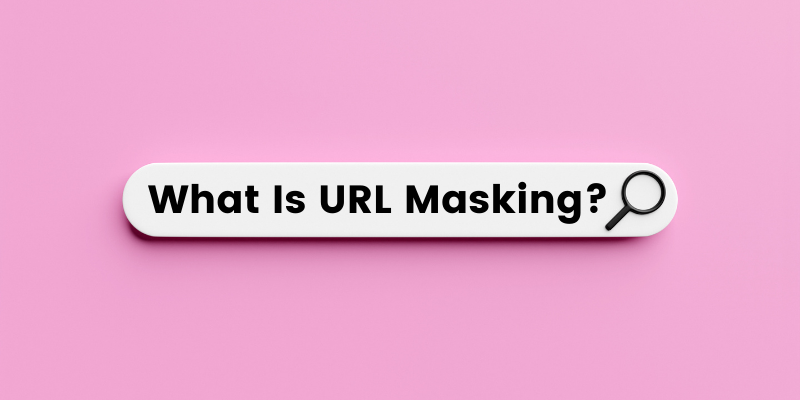
The Importance of URL Masking for Web Security and Privacy
Table of Contents
URL masking is a technique where a different URL is displayed in the browser’s address bar than the actual webpage being viewed. It’s achieved by loading the desired webpage’s content within a frame or iframe on a different webpage. The URL shown in the address bar remains that of the parent webpage, masking the true URL. Often used for branding or hiding affiliate links, URL masking ensures that visitors see a specific domain while accessing content from another. This technique maintains consistency in branding, enhances user experience, and conceals the underlying web address, providing a seamless and cohesive browsing experience.

URL masking is often used for various purposes, including:
- Branding: Companies may use URL masking to maintain consistent branding by displaying their own domain name in the address bar, even if the content is hosted on a different domain or server.
- Affiliate Marketing: Affiliate marketers frequently use URL masking to hide affiliate links, making them appear as if they belong to the affiliate’s own domain rather than the merchant’s domain.
- Shortening URLs: URL masking can be used to create shorter, more user-friendly URLs that are easier to remember and share on social media or other platforms.
- Preserving SEO: In some cases, URL masking is used to preserve the SEO (Search Engine Optimization) benefits of a particular domain while hosting the content on a different server.
- Tracking: Some link tracking software use URL masking to hide tracking tags in the original URL.
While URL masking can be useful for certain purposes, it can also be abused for malicious intent, such as phishing attacks or misleading users about the true destination of a link. As such, it’s important to use URL masking responsibly and transparently, ensuring that users are not misled about the content they are accessing.
Types of URL masking
Here are some common types of URL masking:

- Frame Masking: With frame masking, the content of the desired webpage is loaded within an HTML frame or iframe on a different webpage. The URL displayed in the browser’s address bar remains that of the parent webpage, while the content of the masked URL is displayed within the frame.
- Redirect Masking: Redirect masking involves using server-side redirects to send visitors from one URL to another while keeping the original URL visible in the browser’s address bar. This is often achieved using HTTP 301 or 302 redirects.
- JavaScript Masking: JavaScript can be used to dynamically load content from a different URL onto a webpage without changing the URL displayed in the browser’s address bar. This method is commonly used for AJAX-based content loading and can provide a seamless user experience.
- Proxy Masking: Proxy masking involves routing requests through a proxy server, which retrieves the content from the desired URL and forwards it to the client without revealing the original URL. This method is often used for anonymizing web traffic and bypassing content restrictions.
- HTML Meta Refresh: HTML meta refresh tags can be used to automatically redirect visitors from one URL to another after a specified period of time. While this method is less commonly used for UM it can achieve similar results in certain scenarios.
Each type of URL masking has its own advantages and limitations, and the choice of method depends on factors such as the desired level of security, compatibility with web standards, and user experience considerations. It’s important to use URL masking responsibly and transparently to ensure that users are not misled about the content they are accessing.
Difference between URL masking and URL Forwarding

- URL Masking:
- It involves displaying a different URL in the browser’s address bar than the actual URL of the webpage being viewed.
- When a user visits a masked URL, the content of the desired webpage is typically loaded within a frame or iframe on a different webpage. The URL displayed in the address bar remains that of the parent webpage.
- Masking is often used for branding purposes or to hide affiliate links, making them appear as if they belong to the masking domain.
- The actual URL is not exposed to the visitor, who sees only the masked URL in the address bar.
- URL Forwarding:
- URL forwarding, also known as URL redirection, involves automatically redirecting visitors from one URL to another.
- When a user visits a forwarded URL, their browser is automatically redirected to a different URL specified by the website owner.
- Forwarding can be temporary (HTTP 302 redirect) or permanent (HTTP 301 redirect), depending on the intent of the redirection.
- URL forwarding is commonly used to redirect traffic from old or outdated URLs to new URLs, to redirect traffic from variations of a domain (e.g., example.com, www.example.com) to a single canonical URL, or to redirect visitors from a domain’s non-www version to its www version, or vice versa.
URL-masking involves displaying a different URL in the address bar, while URL forwarding involves automatically redirecting visitors from one URL to another. Both techniques serve different purposes and can be used to manage web traffic effectively based on specific requirements and goals.